Welcome to Sudoku Today!
Today Sudoku contains very many types of variant Sudoku, more types of Sudoku puzzles are still under continuous development, please continue to pay attention to Sudoku today.
Today's Sudoku
13-July-2025
Clone Sudoku
- Place a digit from 1 to 9 into each of the empty squares so that each digit appears exactly once in each of the rows, columns and the nine outlined 3x3 regions.
- Grey cells in the grid represent many cloned areas. Digits in these areas on corresponding positions must be identical. Cloned areas are only moved, without rotation or reflection.
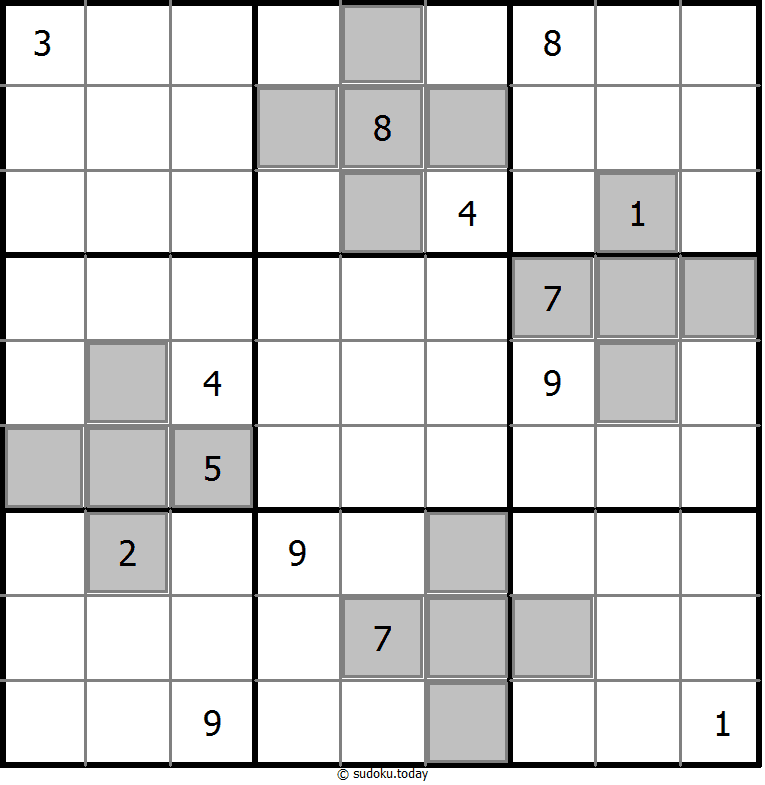
Clone Sudoku
- Place a digit from 1 to 9 into each of the empty squares so that each digit appears exactly once in each of the rows, columns and the nine outlined 3x3 regions.
- Grey cells in the grid represent many cloned areas. Digits in these areas on corresponding positions must be identical. Cloned areas are only moved, without rotation or reflection.
Consecutive Sudoku
- Place a digit from 1 to 9 into each of the empty squares so that each digit appears exactly once in each of the rows, columns and the nine outlined 3x3 regions.
- There are some dots between cells. The numbers on each side of a dot must always be consecutive. All possible dots are marked.
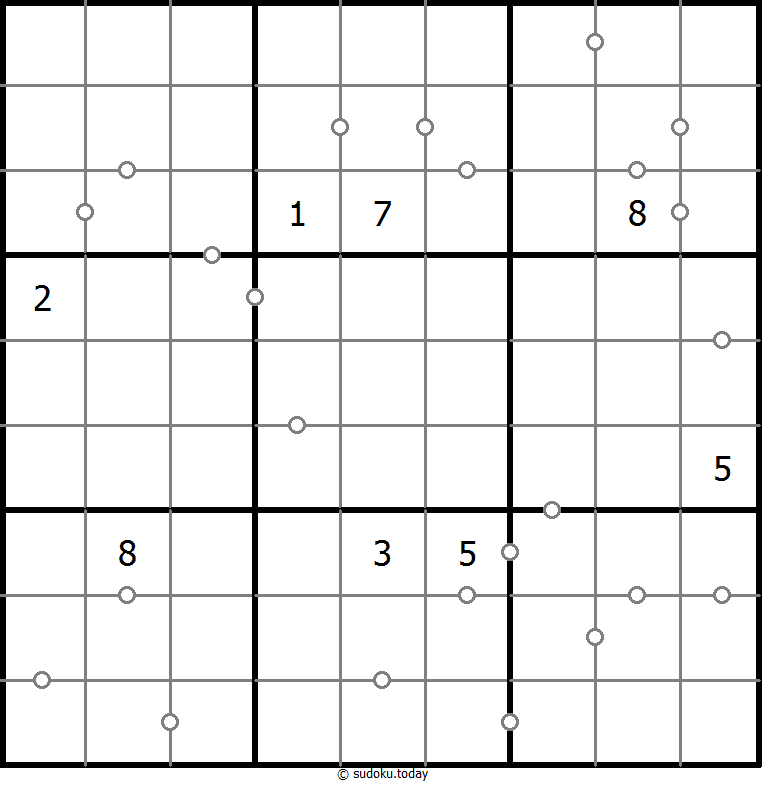
Consecutive Sudoku
- Place a digit from 1 to 9 into each of the empty squares so that each digit appears exactly once in each of the rows, columns and the nine outlined 3x3 regions.
- There are some dots between cells. The numbers on each side of a dot must always be consecutive. All possible dots are marked.
Makodoku
- Place a digit from 1 to 9 into each of the empty squares so that each digit appears exactly once in each of the rows, columns and the nine outlined 3x3 regions.
- A cross between two cells indicates that the product of the numbers in these cells is less than 10. A plus between two cells indicates that the sum of the numbers in these cells is less than 10. If the sum and product are less than 10, then there is a cross between these cells. If there is no sign between two cells, then both sum and product are at least 10.
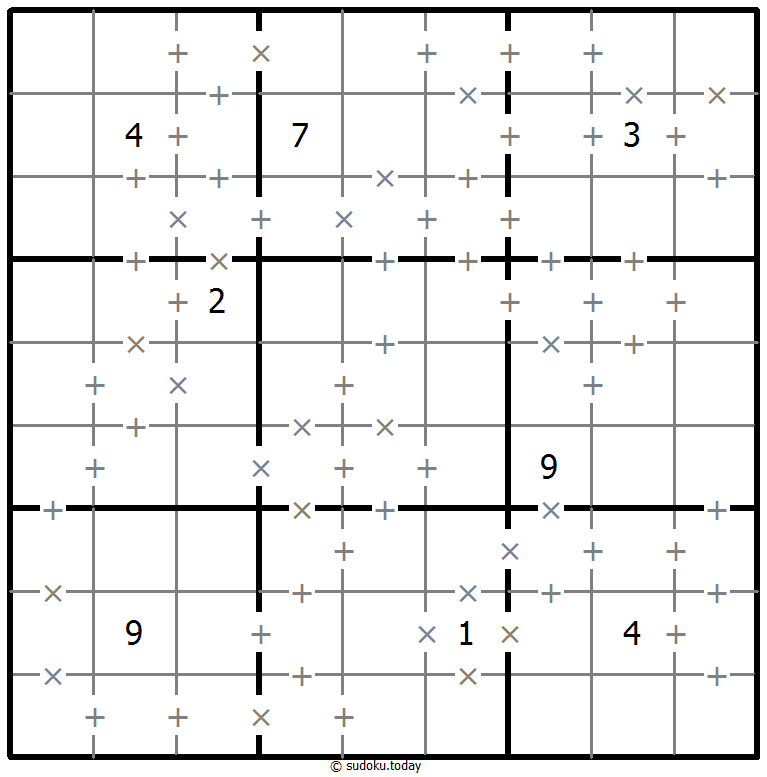
Makodoku
- Place a digit from 1 to 9 into each of the empty squares so that each digit appears exactly once in each of the rows, columns and the nine outlined 3x3 regions.
- A cross between two cells indicates that the product of the numbers in these cells is less than 10. A plus between two cells indicates that the sum of the numbers in these cells is less than 10. If the sum and product are less than 10, then there is a cross between these cells. If there is no sign between two cells, then both sum and product are at least 10.
Ten Box Sudoku
- The diagram is a toroid; some of the 3×3 regions don't end at the right (lower) edge of the diagram but continue at the left (upper) edge of the diagram.
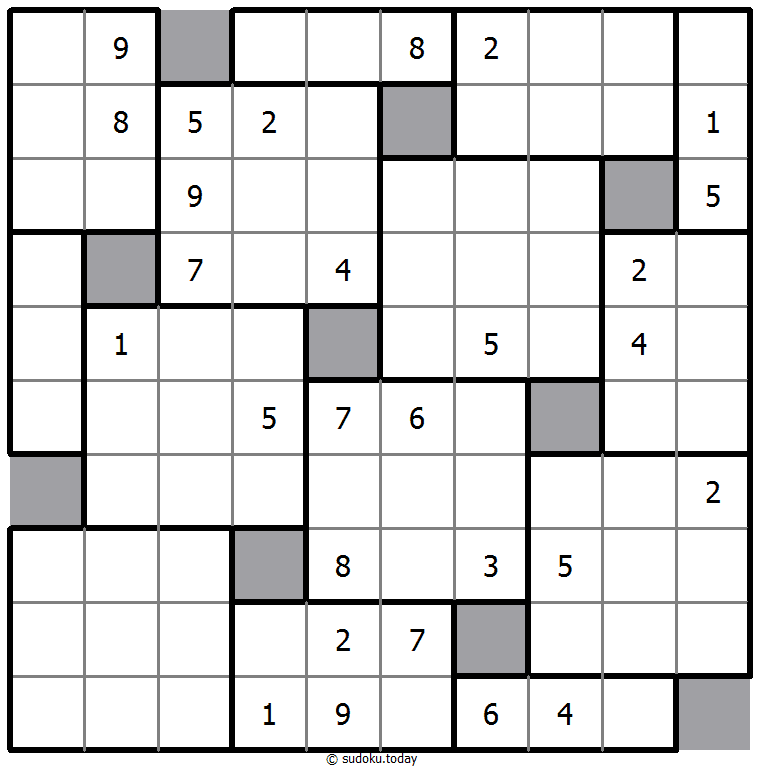
Ten Box Sudoku
- The diagram is a toroid; some of the 3×3 regions don't end at the right (lower) edge of the diagram but continue at the left (upper) edge of the diagram.
Multi Diagonal Sudoku
- Place a digit from 1 to 9 into each of the empty squares so that each digit appears exactly once in each of the rows, columns and the nine outlined 3x3 regions.
- Digits do not repeat along the marked diagonals.

Multi Diagonal Sudoku
- Place a digit from 1 to 9 into each of the empty squares so that each digit appears exactly once in each of the rows, columns and the nine outlined 3x3 regions.
- Digits do not repeat along the marked diagonals.
Kropki Sudoku
- Place a digit from 1 to 9 into each of the empty squares so that each digit appears exactly once in each of the rows, columns and the nine outlined 3x3 regions.
- If absolute difference between two digits in neighbouring cells equals 1, then they are separated by a white dot. If the digit is a half of digit in the neighbouring cell, then they are separated by black dot. The dot between 1 and 2 can be either white or black.

Kropki Sudoku
- Place a digit from 1 to 9 into each of the empty squares so that each digit appears exactly once in each of the rows, columns and the nine outlined 3x3 regions.
- If absolute difference between two digits in neighbouring cells equals 1, then they are separated by a white dot. If the digit is a half of digit in the neighbouring cell, then they are separated by black dot. The dot between 1 and 2 can be either white or black.
Skyscrapers Sudoku
- Place a digit from 1 to 9 into each of the empty squares so that each digit appears exactly once in each of the rows, columns and the nine outlined 3x3 regions.
- Consider each number to be the height of a building. The numbers outside the grid indicate how many buildings can be seen when looking in that direction (taller buildings conceal smaller buildings behind them).
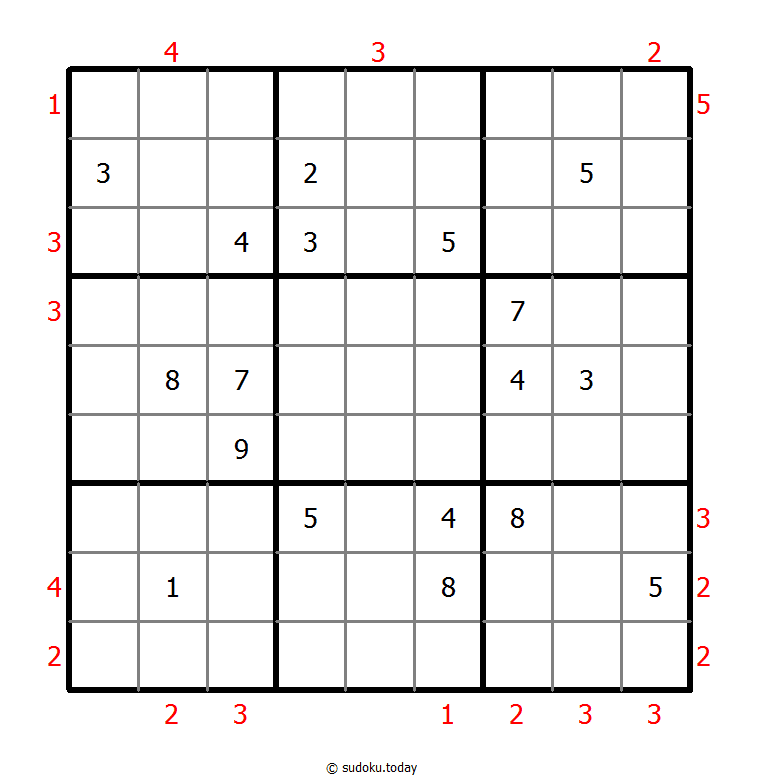
Skyscrapers Sudoku
- Place a digit from 1 to 9 into each of the empty squares so that each digit appears exactly once in each of the rows, columns and the nine outlined 3x3 regions.
- Consider each number to be the height of a building. The numbers outside the grid indicate how many buildings can be seen when looking in that direction (taller buildings conceal smaller buildings behind them).
Arrow Sudoku
- Place a digit from 1 to 9 into each of the empty squares so that each digit appears exactly once in each of the rows, columns and the nine outlined 3x3 regions.
- The sum of the digits along the path of each arrow equals the digit in the circled cell. Digits may repeat within an arrow shape.
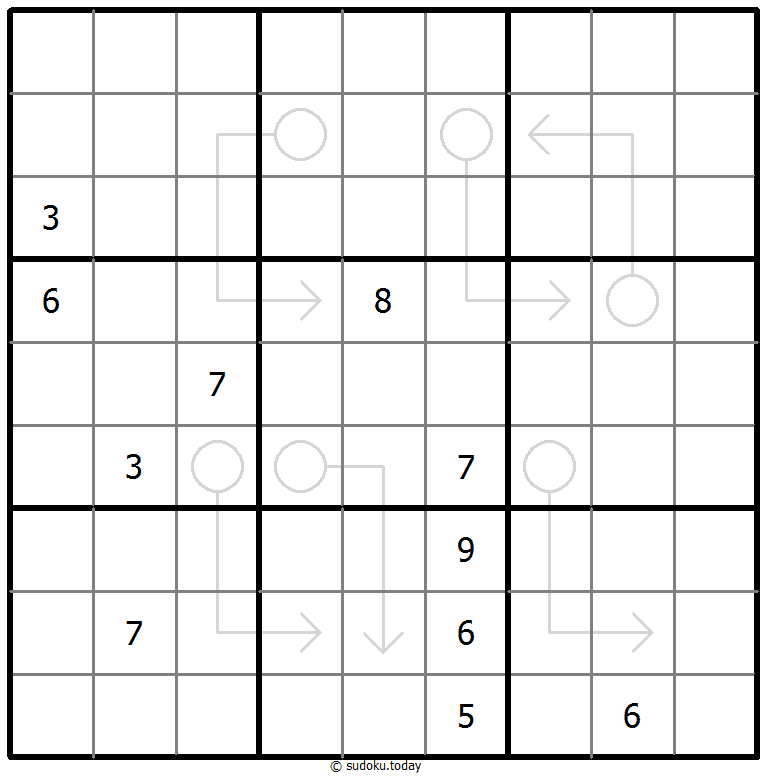
Arrow Sudoku
- Place a digit from 1 to 9 into each of the empty squares so that each digit appears exactly once in each of the rows, columns and the nine outlined 3x3 regions.
- The sum of the digits along the path of each arrow equals the digit in the circled cell. Digits may repeat within an arrow shape.
Hybrid Sudoku ( X Sums + Greater Than )
- Place a digit from 1 to 9 into each of the empty squares so that each digit appears exactly once in each of the rows, columns and the nine outlined 3x3 regions.
- Each number outside the grid is the sum of the first X numbers placed in the corresponding direction, where X is equal to the first number placed in that direction.
- Digits have to be place in accordance with the “greater than” signs.

Hybrid Sudoku ( X Sums + Greater Than )
- Place a digit from 1 to 9 into each of the empty squares so that each digit appears exactly once in each of the rows, columns and the nine outlined 3x3 regions.
- Each number outside the grid is the sum of the first X numbers placed in the corresponding direction, where X is equal to the first number placed in that direction.
- Digits have to be place in accordance with the “greater than” signs.
Quotients Sudoku
- Place a digit from 1 to 9 into each of the empty squares so that each digit appears exactly once in each of the rows, columns and the nine outlined 3x3 regions.
- A number between two cells indicates the quotient of the numbers in these cells. A number between four cells indicates the quotient between two diagonally adjacent cells, either top left + right bottom (\) or top right + bottom left (/).

Quotients Sudoku
- Place a digit from 1 to 9 into each of the empty squares so that each digit appears exactly once in each of the rows, columns and the nine outlined 3x3 regions.
- A number between two cells indicates the quotient of the numbers in these cells. A number between four cells indicates the quotient between two diagonally adjacent cells, either top left + right bottom (\) or top right + bottom left (/).
Palindrome Sudoku
- Place a digit from 1 to 9 into each of the empty squares so that each digit appears exactly once in each of the rows, columns and the nine outlined 3x3 regions.
- Digits along each line read the same from both directions.
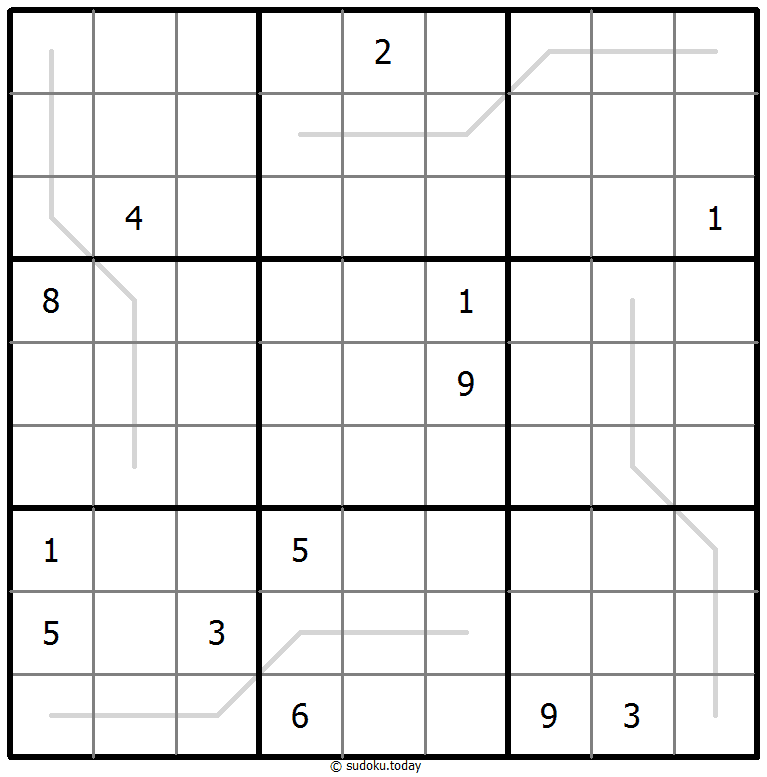
Palindrome Sudoku
- Place a digit from 1 to 9 into each of the empty squares so that each digit appears exactly once in each of the rows, columns and the nine outlined 3x3 regions.
- Digits along each line read the same from both directions.
Parity Lines Sudoku
- Place a digit from 1 to 9 into each of the empty squares so that each digit appears exactly once in each of the rows, columns and the nine outlined 3x3 regions.
- Digits along each marked line are either all odd or all even.
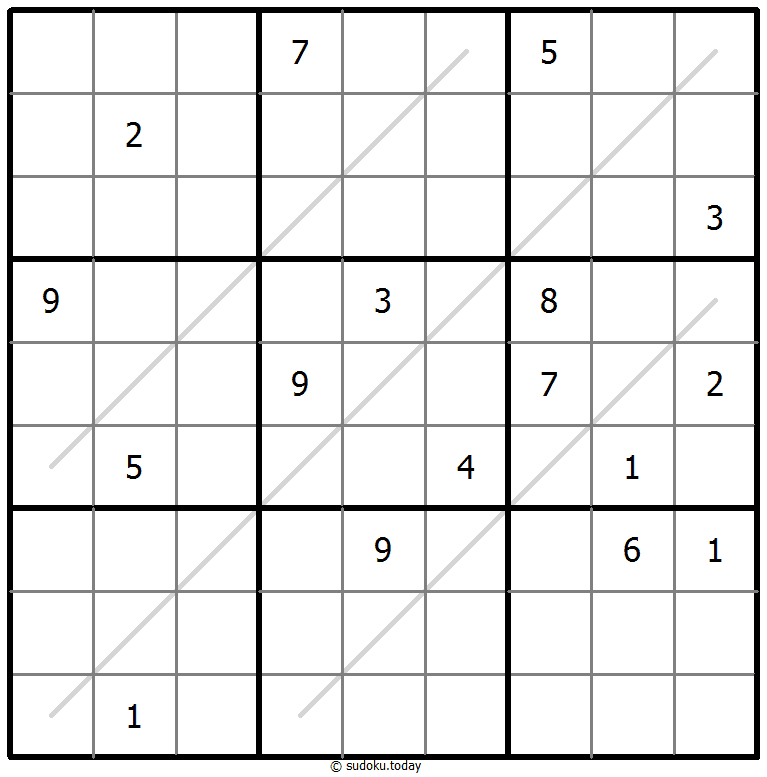
Parity Lines Sudoku
- Place a digit from 1 to 9 into each of the empty squares so that each digit appears exactly once in each of the rows, columns and the nine outlined 3x3 regions.
- Digits along each marked line are either all odd or all even.
Fortress Sudoku
- Place a digit from 1 to 9 into each of the empty squares so that each digit appears exactly once in each of the rows, columns and the nine outlined 3x3 regions.
- If a shaded cell and a white cell are adjacent then the digit in the shaded cell is greater.
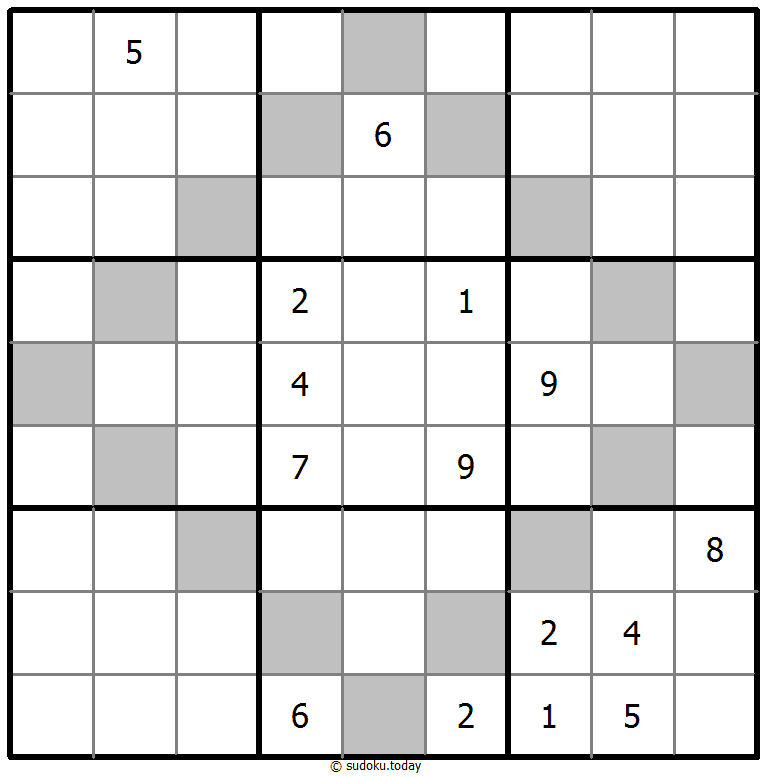
Fortress Sudoku
- Place a digit from 1 to 9 into each of the empty squares so that each digit appears exactly once in each of the rows, columns and the nine outlined 3x3 regions.
- If a shaded cell and a white cell are adjacent then the digit in the shaded cell is greater.
Hybrid Sudoku ( Greater Than + Sum Frame )
- Place a digit from 1 to 9 into each of the empty squares so that each digit appears exactly once in each of the rows, columns and the nine outlined 3x3 regions.
- Digits have to be place in accordance with the “greater than” signs.
- Digits outside the grid indicate the sum of the first 3 digits in the corresponding direction.

Hybrid Sudoku ( Greater Than + Sum Frame )
- Place a digit from 1 to 9 into each of the empty squares so that each digit appears exactly once in each of the rows, columns and the nine outlined 3x3 regions.
- Digits have to be place in accordance with the “greater than” signs.
- Digits outside the grid indicate the sum of the first 3 digits in the corresponding direction.
Answer 8 sudoku
- Place a digit from 1 to 9 into each of the empty squares so that each digit appears exactly once in each of the rows, columns and the nine outlined 3x3 regions.
- A dot between two cells indicates that the result of at least one of the basic operations (addition, subtraction, multiplication, division) of the numbers in these two cells is 8. Is the dot missing, no one of the basic operations results in an 8.

Answer 8 sudoku
- Place a digit from 1 to 9 into each of the empty squares so that each digit appears exactly once in each of the rows, columns and the nine outlined 3x3 regions.
- A dot between two cells indicates that the result of at least one of the basic operations (addition, subtraction, multiplication, division) of the numbers in these two cells is 8. Is the dot missing, no one of the basic operations results in an 8.
Point To Next Sudoku
- Place a digit from 1 to 9 into each of the empty squares so that each digit appears exactly once in each of the rows, columns and the nine outlined 3x3 regions.
- If digit ‘n’ is placed in a cell with an arrow, digit ‘n+1’ must be placed in one of the cells pointed by the arrow.

Point To Next Sudoku
- Place a digit from 1 to 9 into each of the empty squares so that each digit appears exactly once in each of the rows, columns and the nine outlined 3x3 regions.
- If digit ‘n’ is placed in a cell with an arrow, digit ‘n+1’ must be placed in one of the cells pointed by the arrow.
Skyscrapers Sudoku
- Place a digit from 1 to 9 into each of the empty squares so that each digit appears exactly once in each of the rows, columns and the nine outlined 3x3 regions.
- Consider each number to be the height of a building. The numbers outside the grid indicate how many buildings can be seen when looking in that direction (taller buildings conceal smaller buildings behind them).
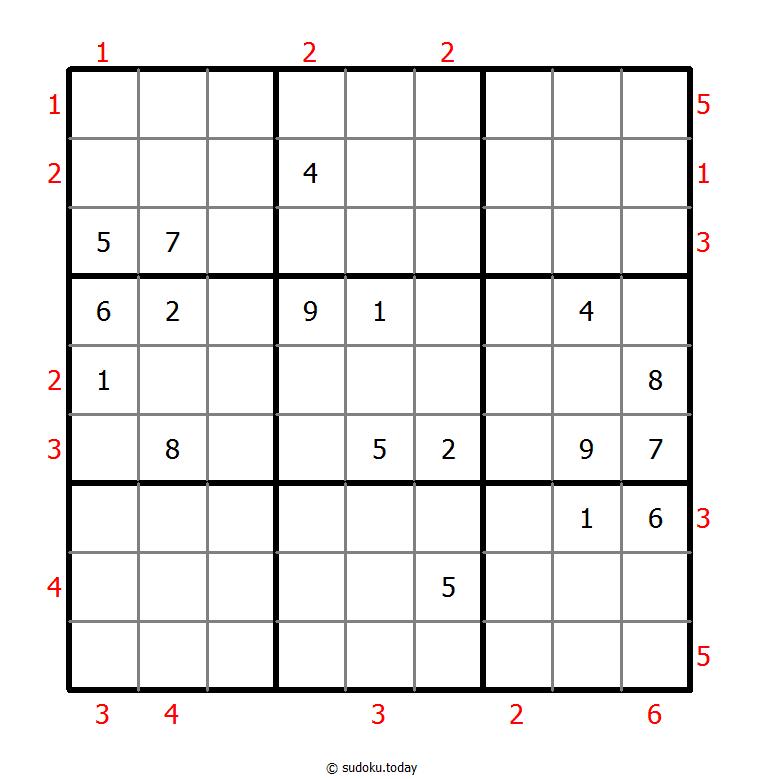
Skyscrapers Sudoku
- Place a digit from 1 to 9 into each of the empty squares so that each digit appears exactly once in each of the rows, columns and the nine outlined 3x3 regions.
- Consider each number to be the height of a building. The numbers outside the grid indicate how many buildings can be seen when looking in that direction (taller buildings conceal smaller buildings behind them).
Arrow Sudoku
- Place a digit from 1 to 9 into each of the empty squares so that each digit appears exactly once in each of the rows, columns and the nine outlined 3x3 regions.
- The sum of the digits along the path of each arrow equals the digit in the circled cell. Digits may repeat within an arrow shape.
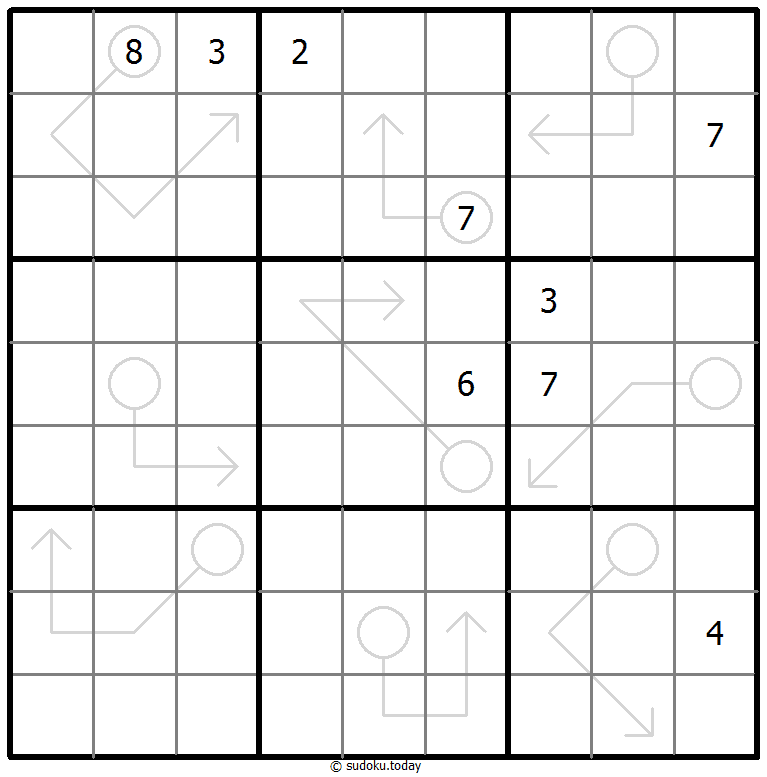
Arrow Sudoku
- Place a digit from 1 to 9 into each of the empty squares so that each digit appears exactly once in each of the rows, columns and the nine outlined 3x3 regions.
- The sum of the digits along the path of each arrow equals the digit in the circled cell. Digits may repeat within an arrow shape.
Neighbourship Sudoku
- Place a digit from 1 to 9 into each of the empty squares so that each digit appears exactly once in each of the rows, columns and the nine outlined 3x3 regions.
- A number in a squared cell indicates how many different numbers the four diagonally adjacent cells contain. A number in a circled cell indicates how many different numbers the eight orthogonally and diagonally adjacent cells contain.
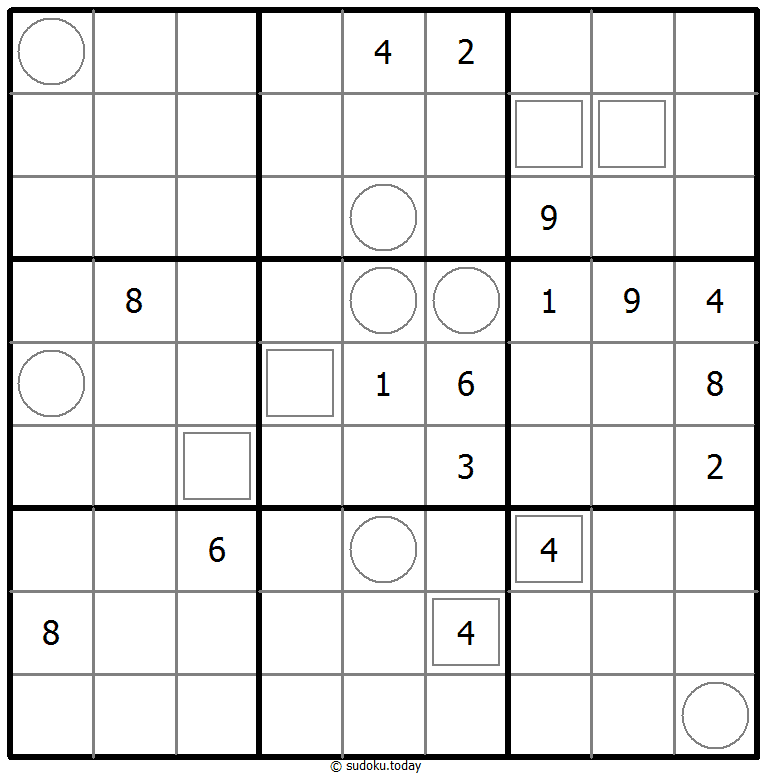
Neighbourship Sudoku
- Place a digit from 1 to 9 into each of the empty squares so that each digit appears exactly once in each of the rows, columns and the nine outlined 3x3 regions.
- A number in a squared cell indicates how many different numbers the four diagonally adjacent cells contain. A number in a circled cell indicates how many different numbers the eight orthogonally and diagonally adjacent cells contain.
Maximin Sudoku
- Place a digit from 1 to 9 into each of the empty squares so that each digit appears exactly once in each of the rows, columns and the nine outlined 3x3 regions.
- A number at the edge of the diagram indicates the difference between the highest and the lowest number in the first three cells in the corresponding row or column.

Maximin Sudoku
- Place a digit from 1 to 9 into each of the empty squares so that each digit appears exactly once in each of the rows, columns and the nine outlined 3x3 regions.
- A number at the edge of the diagram indicates the difference between the highest and the lowest number in the first three cells in the corresponding row or column.

